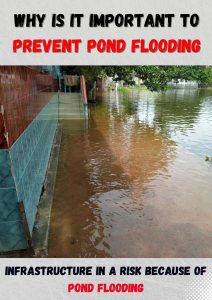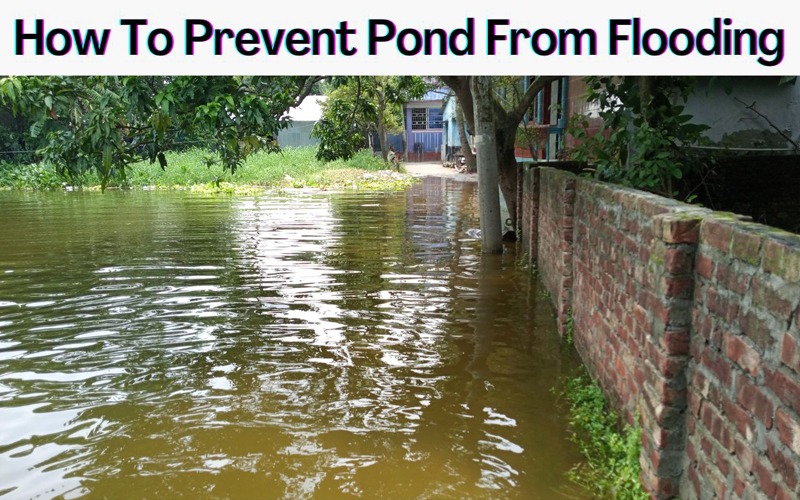During heavy rain or rainfall, there is a risk that the pond can flood if your pond is not made or designed by a well-planned or professional. Without a well-planned design, there are lots of reasons why light and heavy rains can cause flooding from ponds. So, if flooded, how to prevent the pond from flooding?
There are several ways to stop ponds from flooding such as by assessing pond capacity, outlet structure maintaining, controlling the inflow of water, enhancing pond vegetation, and other ways.
Today in this article we will tell you how to stop ponds from flooding and why it is important to prevent pond flooding. So without wasting time let’s see the proper ways to reduce the risk of flooding from a pond.
Check These Nets On Amazon For Protecting Fishes During Flood
- Top-Rated Of All: CreiYuan Heavy Duty 15 x 20FT Pond Netting
- For Small Pond: Pond Armor SKU-GRAY-QT-R Non-Toxic Pond Shield
- Best For Large Pond: GZGREAT, Fish Protective Pond Netting For Flood Floating
How To Stop Pond Overflowing
Although preventing pond flooding is crucial and it can cause effects the pond ecosystem. Yes, pond flooding is directly connected with heavy rainfall. And during rainfall, lots of things happen in a pond.
Anyway, here we will explore various methods and strategies to prevent pond flooding. So let’s see what steps should be taken to stop flooding from a pond.
Assessing Pond Capacity
First of all, you should evaluate the capacity of your pond to prevent flooding of your pond. Evaluate your capacity to handle water volume during heavy rainfall.
First, determine your pond’s current water-holding capacity and then compare it to the expected water volume during extreme rainfall. If the pond’s capacity is not enough you should consider expanding the pond.
Outlet Structure Maintenance
To stop the flood of a pond you should focus on the outlet structures. Because a properly functioning outlet structure is essential for managing water levels and reducing flooding risks.
Try to inspect and maintain the outlet structure regularly and ensure it is free of debris and operating efficiently. If any obstructions may impede water flow then clear it, and check for any signs of damage or erosion. Repair or replace if needed.
Controlling The Inflow Of Water
It’s an important step that you must take to stop flooding from your pond. During heavy rain, consider implementing measures to divert the extra rainwater away.
You can install a diversion structure like a swale or diversion ditch, which can redirect water runoff away from the pond and reduce the risk of flooding.
Enhancing Pond Vegetation
Sometimes, pond vegetation in the right area can significantly contribute to flood prevention. Especially on slopes and erosion-prone areas, helps stabilize the soil and improve water absorption.
You can plant grasses, native wetland plants, or other species with deep root systems which can prevent runoff. You can also put some water hyacinths on the edge of your pond. And if you don’t know how to put water hyacinth in a pond then you can check our previous article.
By providing flood protection these plants can also enhance the overall aesthetic and ecological value of your pond.
Constructing Sediment Basins
Constructing well-planned sediment basins can be a good idea to prevent pond flooding. You can strategically construct a sediment basin upstream of the pond. Remember, sediment basins require regular maintenance, including sediment removal.
Installing Water Control Structures
Sometimes, it’s hard to control water overflow manually, so you should use some technology. In your pond, you can install a sluice gate or adjustable outlet that allows you to regulate the inflow and outflow of water.
Yes, a pond sluice gate can help you to control water flow during heavy rain and avoid unexpected flooding. Especially sluice gate in fish ponds is necessary to save fishes and aquatic animals.
Regular Maintenance
Regular maintenance must be needed to keep a pond safe and balance the ecosystem. Yes, the ecosystem of your pond is so important for your pond’s aquatic plants and animals.
Sometimes, certain types of water plants like water hyacinths can grow rapidly which can cause problems to your pond’s ecosystem. So you should know how you can get rid of the water hyacinth of a pond.
Anyway, regularly take proper care of your pond and make sure that your pond capacity is enough and your pond can work against the overflow of heavy rain.
Consult With Experts
If you already applied the steps that we have shown above or the structure of your pond is not suitable for these steps then you can contact an expert or civil engineer.
They can specify the problem of your pond and give you a perfect solution to avoid flooding your pond.
So these are the essential steps that you should take to prevent pond flooding. We hope now it’s clear to you how to prevent the pond from flooding during heavy rain or heavy flow.
Why Is It Important To Prevent Pond Flooding

We have already told you how to stop a pond from flooding. We know flooding is a natural process that can happen because of heavy rain. But why is it important to prevent pond flooding?
There are multiple reasons why you should prevent pond flooding, such as protecting surrounding areas, maintaining water quality, safe aquatic animals from floating away, preventing soil erosion, and more. Here we will describe the importance of preventing pond flooding.
Protecting Surrounding Areas
When a pond floods, it can cause damage to nearby structures, landscapes, and other infrastructure. As an example, I can say that when my pond floods it effect a building base that is right in front of my pond.
And this infrastructure is a risk because of my pond, that’s why I try to avoid unexpected flooding in my pond. And flooding in a pond can lead to soil erosion, and property damage, and even pose risks to human safety. Additionally, this is the main reason why you should prevent pond flooding.
Maintaining Water Quality
Because of unexpected flooding, your pond can introduce pollutants and sediment. Even flooding can introduce excess nutrients into the pond, which can imbalance the pond’s ecosystem.
As a result, you can notice poor water quality, leading to algal blooms, reduced oxygen levels, and harm to aquatic organisms. So, to maintain the water quality and control a balanced ecosystem you should prevent flooding in your pond.
If you don’t know about the testing process of pond water then you should stay connected with our blogs, soon you will see the process.
Preserving Aquatic Habitat
As we mentioned before, flooding can imbalance your pond ecosystem which can affect aquatic plants, fish, and other organisms. Excessive water levels and sudden flooding can cause habitat loss, changes in water temperature, and decreased oxygen availability.
To ensure a balanced ecosystem for your pond, you should take steps to avoid flood in your pond.
Preventing Soil Erosion
Flooding can cause soil erosion, leading to sedimentation and reduced water-holding capacity. As an example, I can say about our family pond, which was 0.80 acre 15 years ago, and now it’s almost 1 acre in size.
And the amazing part is we didn’t dig it for once to expand its size, it expand naturally. So you should prevent flooding to stop soil erosion from your pond. Otherwise, your pond’s depth can reduce.
So, stop flooding your pond for maintaining the ecological balance, protect surrounding areas, enhance water quality, and maintain a balanced ecosystem.
If you have more questions about ponds and ponds flooding then ask us in the below comment. Share this article with your friends who have ponds and who are interested in fish farming. Stay connected with our blogs to get regular updates from us.





